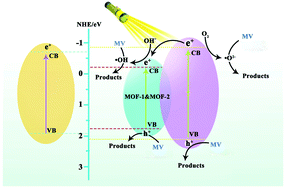Two highly stable metal–organic frameworks (MOFs) assembled by a flexible 1,4-bis(2-methylimidazol-1-yl)butane (bib), and two different aromatic carboxylate coligands, namely, [Zn(BDC–OH2)(bib)] (1) and [Cd3(BTC)2(bib)(DMF)3] (2) (H2BDC–OH2 = 2,5-dihydroxyterephthalic acid, H3BTC = 1,3,5-benzenetribenzoic acid), were designed and synthesized. 1 showed a 4-fold interpenetration of 4-connected dia-type topological net. In 2, the 3D topological structure can be viewed as a (3,4,5)-connected network, and its Schläli point is {4·62}2 {42·6·83} {46·89}. Different auxiliary carboxylate ligands were examined with respect to the building of various structures. 1 and 2 have outstanding photocatalytic behaviors for the disintegration of methyl violet (MV) under UV irradiation.
